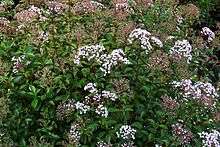Ageratina ligustrina
| Ageratina ligustrina | |
|---|---|
 | |
| Ageratina ligustrina | |
| Scientific classification | |
| Kingdom: | Plantae |
| (unranked): | Angiosperms |
| (unranked): | Eudicots |
| (unranked): | Asterids |
| Order: | Asterales |
| Family: | Asteraceae |
| Subfamily: | Asteroideae |
| Tribe: | Eupatorieae |
| Genus: | Ageratina |
| Species: | A. ligustrina |
| Binomial name | |
| Ageratina ligustrina (DC.) R.M.King & H.Rob. | |
| Synonyms[1] | |
|
Synonymy
| |
Ageratina ligustrina (privet-leaved ageratina, privet-leaved snakeroot), is Mesoamerican species of evergreen flowering shrub in the sunflower family. It is widespread across much of Mexico and Central America from Tamaulipas to Costa Rica.[2][3][4]
Ageratina ligustrina grows to 4 metres tall, producing flat heads of daisy-like white composite flower-heads in autumn. It is not fully hardy in temperate regions.[5] In cultivation it has gained the Royal Horticultural Society's Award of Garden Merit.[6]
The Latin specific epithet ligustrina highlights the plant's resemblance to the privet Ligustrum, though the two plants are not believed to be closely related.[7]
Eupalin and eupatolin are flavonol rhamnosides isolated from E. ligustrinum.[8]
References
- ↑ The Plant List Ageratina ligustrina (DC.) R.M.King & H.Rob.
- ↑ Turner, B. L. 1997. The Comps of Mexico: A systematic account of the family Asteraceae, vol. 1 -- Eupatorieae. Phytologia Memoirs 11: i–iv, 1–272
- ↑ Linares, J. L. 2003 [2005]. Listado comentado de los árboles nativos y cultivados en la república de El Salvador. Ceiba 44(2): 105–268.
- ↑ Berendsohn, W.G., A. K. Gruber & J. A. Monterrosa Salomón. 2009. Nova silva cuscatlanica. Árboles nativos e introducidos de El Salvador. Parte 1: Angiospermae - Familias A a L. Englera 29(1): 1–438.
- ↑ RHS A-Z encyclopedia of garden plants. United Kingdom: Dorling Kindersley. 2008. p. 1136. ISBN 1405332964.
- ↑ "RHS Plant Selector - Ageratina ligustrina". Retrieved 19 July 2013.
- ↑ Harrison, Lorraine (2012). RHS Latin for gardeners. United Kingdom: Mitchell Beazley. p. 224. ISBN 9781845337315.
- ↑ The structures of eupalin and eupatolin. Two new flavonol rhamnosides isolated from Eupatorium ligustrinum D.C. L. Quijano, F. Malanco and Tirso Ríos, Tetrahedron, Volume 26, Issue 12, 1970, pages 2851-2859, doi:10.1016/S0040-4020(01)92863-7
External links
| Wikispecies has information related to: Ageratina ligustrina |
| Wikimedia Commons has media related to Ageratina ligustrina. |
This article is issued from Wikipedia - version of the 9/16/2015. The text is available under the Creative Commons Attribution/Share Alike but additional terms may apply for the media files.